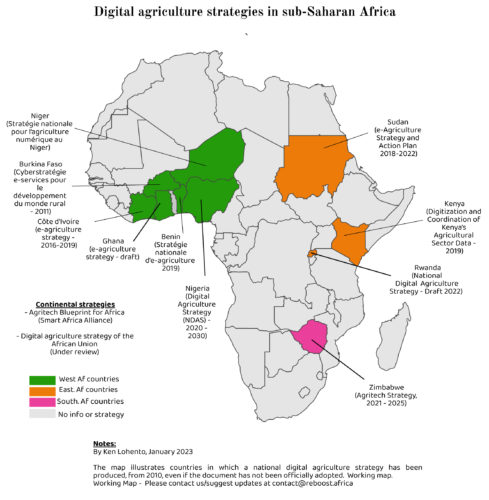A national e-agriculture (or digital agriculture) strategy promotes the emergence of a common understanding of issues related to adopting digital technology for agrifood systems performance. It favours the deployment in the synergy of transformational actions. The design of these policy documents has accelerated in recent years in Africa. The first attempts started in the mid-2000s with the insertion of a chapter relating to agriculture in digital development strategies. Since the 2010s, the movement has accelerated with the development of dedicated strategies. Côte d’Ivoire thus developed an e-agriculture strategy in 2012 with the support of the World Bank. Rwanda also confirmed its strong interest in using digital technology for development by preparing such a strategy in 2015. This country had already stood out in the early 2000s by substantively covering the agriculture sector in its National Information and Communication Infrastructure (NICI) strategy document.
The development of the Guide on e-Agriculture Strategies by the Food and Agriculture Organization of the United Nations (FAO) and the International Telecommunication Union (ITU), with partners such as the former Technical Center of Agricultural and Rural Cooperation (CTA), was an important milestone. After some Asia Pacific and Eastern Europe countries, FAO and ITU helped Benin to design its e-agriculture strategy in 2019. Niger (with GIZ contributions), Ghana, and Rwanda (an update of a previous strategy) have recently been supported, and other countries such as Madagascar are planned. In 2019, apparently through a partnership with the World Bank, Kenya developed a strategic document under the leadership of the Ministry of Agriculture, Livestock, Fisheries and Irrigation (MoALFI). More specifically, it serves as an operational tool for Flagship Programme No. 8 of the National Strategy for the Transformation and Growth of the Agricultural Sector. Zimbabwe also adopted an “Agritech strategy”, in the context of the design of digital blueprints promoted by the intergovernmental Alliance “Smart Africa”. Other countries with a strategy include Nigeria and Sudan; Togo prepared in 2020, with the support of CTA, a digital strategy note for the transformation of the sector, which may be considered a transitional policy document.
Another key milestone is developing a digital agriculture strategy for the African Union in 2022 by its Department in charge of agriculture (this document is being validated) so that it can better support countries in the digitalization of their agricultural sector; the strategy was developed with European Union support. It should be noted that Smart Africa also adopted an “AgriTech Blueprint for Africa”, which is a good reference material.
Unfortunately, some of these strategies have not been formally adopted by governments and made available to stakeholders to guide their initiatives (achieving national strategies’ objectives does not only depend on governments). Official adoption processes sometimes take more than a year due to ministerial or governmental administrative procedures. Moreover, developing a strategy is not a panacea. Effective implementation often faces daunting difficulties, particularly the mobilisation of financial resources required for implementing identified projects.
This map will be updated whenever possible. It highlights countries that have developed, since the 2010s, documents that have considered digital agriculture strategies, even though some have not been updated or have not yet been officially adopted by governments.
Some of the e-strategies available online (not all on official websites):
- Benin
- Rwanda (there is a security warning sometimes for this website)
- Nigeria
- Kenya
- Smart Africa Agritech Blueprint for Africa
For more information: https://www.kenlohento.site/mapping-digital-agriculture-strategies-in-africa/
Written by: Ken Lohento

